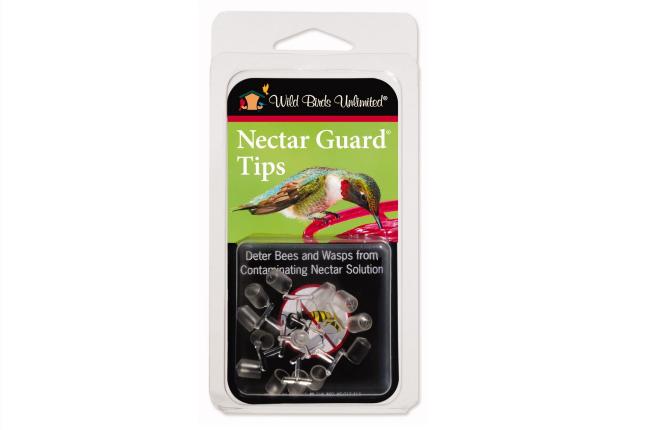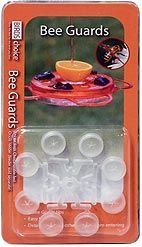How do I Stop Wasps?
Before we get into to solving wasp problems we would like to emphasis that bees and wasps while related to each other are very different in their biology and life habits. This page is aimed only at discouraging Yellow Jacket Wasps (Vespula species) and Bald-faced Hornets (Dolichovespula maculata) away from bird feeders. Bees are an essential part of any backyard habitat. Many of the bees that live around our yards and pollinate our gardens are small, do not sting and are a vital part to the health of the environment. It should also be noted that many species of wasps that are not nuances at bird feeders such as Mud Dauber wasps and can be enjoyed in backyard habitats as well. There are also several species of flower flies (Family Syrphidae) that imitate bees and wasps but are simply harmless pollinators in our gardens. Please do not harm any beneficial insects in your garden.

Wasp Species, Photo by Kristen Martyn
Bees and wasps differ greatly in appearance and behavior. Generally speaking bees are wide insects with round body parts and they also have hairy bodies and legs. Bees are non-aggressive and rely on pollen and nectar for their food, they don’t typically prey on other insects. Wasps on the other hand have thin and cylindrical body parts with smooth bodies and legs. One of a wasps key characteristic is the narrow junction between thorax and abdomen. They typically live in papery nests and can be quite aggressive. Wasps and hornets prey on other insects.
Typically Yellow Jackets and Bald-faced Hornets only begin to become a problem at bird feeders in the late summer and early fall. In late summer and fall, normal food materials for wasps and hornets are in short supply and populations of these animals is very high. Yellow Jackets and Bald-faced Hornets will scavenge for alternate food sources, which leads to major conflicts with human activities. They are attracted to carbonated beverages, juices, candy, various meats, cakes, fruit, vegetables, ice cream and of course bird food. Yellow Jackets and Bald-faced Hornets typically enjoy bird foods that are sticky and sweet such as nectar (for hummingbirds, orioles and butterflies), BirdBerry Jelly (for oriole) and fruit. Sometime they may be a little more adventures and eat suet; however this is typically suet flavours with fruit in them. The most annoying part of Yellow Jackets and Bald-faced Hornets visiting feeders is their highly aggressive nature means they scare off many birds.
As intimidating as these insects are there are great ways to deal with Yellow Jackets and Bald-faced Hornets visiting your bird feeders.
Please note that all of information provided on our website about our products is meant to be informative only. For more information regarding prices and shipping (within Canada only) please visit our store in Barrie (515 Bryne Drive, Barrie, ON), phone us (705) 726-7600 or send us an email [email protected].
Here are our 6 Rules for Keeping out Yellow Jackets and Bald-faced Hornets
1. Protect Your Hummingbird Feeder With WBU Nectar Guard® Tips: The good news is we have an excellent product that keeps Yellow Jackets and Bald-faced Hornets out of our WBU Hummingbird Feeders. WBU Nectar Guard® Tips are a small plastic coating that slips over top of the feeding hole blocking out wasps and hornets; but still allowing your hummingbirds to feed. It’s an excellent way to keep your nectar fresh. WBU Nectar Guard® Tips can fit onto any of our WBU Hummingbird Feeders including:
- WBU Pagoda High Perch™ Hummingbird Feeder
- WBU High Perch™ Hummingbird Feeder
- WBU Small High Perch™ Hummingbird Feeder
- WBU High Perch Large Hummingbird Feeder
- WBU Mini High Perch™ Hummingbird Feeder
- WBU Decorative Window Hummingbird Feeder
- WBU Mini™ Decorative Window Hummingbird Feeder

WBU Nectar Guard® Tips: The WBU Nectar Guard® Tips protect nectar solution from bee and wasp contamination by creating a barrier that deters bees and wasps. Tips easily slide onto the feeding ports on the underside of the feeding cover. Each tip has a flexible center that opens when a hummingbird inserts its beak to feed and closes tightly when it removes its beak. The WBU Nectar Guard® Tips come in a package of 12 and fit onto any of our WBU Hummingbird Feeders.
 Bee Guards: These Bee Guard Tips protect your nectar solution from bee and wasp contamination by creating a barrier that deters bees and wasps. Tips easily slide onto the feeding ports on the underside of the feeding cover. Each tip has a flexible center that opens when an oriole or hummingbird inserts its beak to feed and closes tightly when it removes its beak. The Bee Guard® Tips come in a package of 8 and fit onto our WBU 3-in-1 Oriole Feeder.
Bee Guards: These Bee Guard Tips protect your nectar solution from bee and wasp contamination by creating a barrier that deters bees and wasps. Tips easily slide onto the feeding ports on the underside of the feeding cover. Each tip has a flexible center that opens when an oriole or hummingbird inserts its beak to feed and closes tightly when it removes its beak. The Bee Guard® Tips come in a package of 8 and fit onto our WBU 3-in-1 Oriole Feeder.
2. Trap them! Use a glass wasp trap and bait them with a simple sugar solution, beer, pop, juice or just about any other sweet liquid you can think of! It's a non-toxic way to trap wasps and works great!
Glass Wasp Traps: Are wasps and yellow jackets ruining your family picnics? Don't like those industrial wasp traps from the hardware store that use dangerous chemicals? Try our classic Glass Wasp Traps made from a high quality, thick glass in a classic beehive shape. These wasp traps are an all-natural way to control wasps and they hang beautifully in any garden or outdoor living space. A sturdy cork top keeps the pests from getting away and a stylish wire hanger adds to the appeal of this lovely trap. Not only do these wasp traps look good, but they work great as well. Simply fill the inner reservoir with just a little soda or sugar water to attract the wasps and once they are inside they are stuck and you can enjoy your outdoor gatherings. They also feature legs so that these wasp traps can either be placed on a table or hung to protect your party. These wasp traps are stylish, functional and don't require the use of harmful chemicals an organic and natural way to manage wasps.
 3. Only Use Feeders without the Colour Yellow: Yellow Jackets and Bald-faced Hornets are attracted to the colours white and yellow; but are unable to see the colour red. Many hummingbird feeders on the market have yellow wasp guards or decorative flowers surrounding the feeding ports (pictured to the right). This is an invitation for wasps and hornets to visit your bird feeders! Our WBU Barrie Hummingbird Feeders do not contain any yellow on the feeders or feeder ports.
3. Only Use Feeders without the Colour Yellow: Yellow Jackets and Bald-faced Hornets are attracted to the colours white and yellow; but are unable to see the colour red. Many hummingbird feeders on the market have yellow wasp guards or decorative flowers surrounding the feeding ports (pictured to the right). This is an invitation for wasps and hornets to visit your bird feeders! Our WBU Barrie Hummingbird Feeders do not contain any yellow on the feeders or feeder ports.
An example of a feeder with yellow perches that attracts wasps
4. Switch to Suet, Cylinder and Stackables™ Flavours without Fruit: Some of our most popular suet, cylinder and Stackables™ flavours contain fruit which can be very attractive to Yellow Jackets and Bald-faced Hornets. For the late summer and early fall consider switching to a flavor of suet, cylinder and Stackables™ that don’t contain any fruit including:
- WBU Supreme Seed Cylinder
- WBU Deluxe Seed Cylinder
- WBU Woodpecker Cylinder
- WBU Hot Pepper Cylinder
- WBU Safflower Seed Cylinder
- WBU Nutty for Nuts Cylinder
- WBU Naturally Nuts™ No-melt Suet Dough Cylinder
- WBU Nutty for Nuts™ Stackables™
- WBU Naturally Nuts® No-melt Suet Dough Stackable™
- WBU Bird Bug Bites Suet
- WBU Naturally Nuts® Suet
- WBU Simply Suet®
- WBU Bird Bug Bites No-melt Dough
- WBU Naturally Nuts® No-melt Dough
- WBU Hot Pepper No-melt Dough
- WBU Woodpecker Cake
- WBU Bark Butter® Plugs
5. Switch from BirdBerry Jelly to Mealworms: One of the foods that is most attractive to Yellow Jackets and Bald-faced Hornets is our BirdBerry Jelly for orioles and other fruit eating birds. Orioles also enjoy live insects especially during the late summer so one option for your orioles is to switch from offering BirdBerry Jelly to offering live mealworms, which can be accommodated in many oriole feeders. Yum yum!
6. Replace Feeders that Aren’t Doing their Job: Some bird feeders on the market don’t take into account wasps and hornets visiting the feeder or causing problems. The last step would be to replace a feeder that cannot keep wasps and hornets away with one that will solve the problem. For example taking down your old hummingbird feeder that has yellow feeding ports and replacing it with a WBU Hummingbird Feeder that contains no yellow and can accommodate WBU Nectar Guard® Tips.


